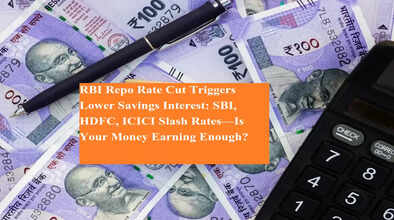RBI Repo Rate Cut Triggers Lower Savings Interest: SBI, HDFC, ICICI Slash Rates—Is Your Money Earning Enough?

Bank Interest Rates Update – June 2025:
If you're relying on your savings account interest as a steady source of passive income, there’s important news you shouldn't ignore. The Reserve Bank of India (RBI) has recently slashed the repo rate by 50 basis points, prompting major Indian banks—including SBI, HDFC, ICICI, IndusInd Bank, and Bank of Baroda—to reduce interest rates on savings deposits across the board.
This cut means lower earnings on your idle money, whether you have ₹10,000 or ₹10 crore in your account. The changes are uniform, affecting both small and large depositors. So now may be the perfect time to reassess your financial strategy and explore better-yielding alternatives.
📉 What Is the Repo Rate and Why It Matters?
The repo rate is the rate at which the RBI lends short-term funds to commercial banks. When the RBI reduces this rate, banks' borrowing costs drop. This often leads to lower interest payouts on savings accounts, fixed deposits, and loan interest rates.
While a cut in repo rate is usually celebrated for making loans cheaper, the downside is that savings interest rates also fall, reducing the passive income many savers rely on.
🏦 Updated Savings Account Interest Rates – June 2025
Here’s how some of the country’s leading banks have revised their savings account interest rates:
| Bank Name | Revised Savings Interest Rate (Per Annum) |
|---|---|
| State Bank of India (SBI) | 2.70% |
| HDFC Bank | 3.00% |
| ICICI Bank | 3.00% |
| IndusInd Bank | 3.50% (on balances below ₹1 lakh) |
| Bank of Baroda | 2.75% |
These reduced rates are applicable to all deposit amounts, eliminating the earlier tier-based structure where higher balances earned slightly more interest. Now, regardless of how much you’ve saved, your money earns the same, lower rate.
💡 Why This Impacts Your Financial Planning
Let’s take a real-world example. Suppose you keep ₹5,00,000 in a savings account earning 3% annual interest. That gives you ₹15,000 in yearly income before tax. But if the rate drops to 2.7%, your earnings reduce to just ₹13,500—a ₹1,500 drop without any change in your saving habits.
This might seem small in isolation, but over the years and on larger amounts, it significantly dents your returns. Moreover, when adjusted for inflation, your savings could actually be losing value in real terms.
📊 What Can Savers Do?
If your goal is to grow your money while keeping it relatively safe, here are a few better alternatives to consider:
-
Fixed Deposits (FDs): Still offer higher returns than savings accounts. Compare FD rates across banks for the best deal.
-
Recurring Deposits (RDs): Help build disciplined savings with fixed monthly deposits and guaranteed interest.
-
Liquid Mutual Funds: Offer better returns than savings accounts with relatively low risk.
-
High-Interest Digital Banks or Small Finance Banks: These often provide savings interest rates between 5–7% for smaller balances.
-
Senior Citizen Schemes or PPF: Long-term options that offer government-backed returns.
📌 Key Takeaways
-
The RBI's 50 basis point repo rate cut has led to lower interest rates on savings accounts at leading banks.
-
SBI, HDFC, ICICI, IndusInd Bank, and Bank of Baroda have revised rates downward, impacting all account holders equally.
-
With most savings rates now hovering between 2.7% to 3.5%, your returns on idle funds are shrinking.
-
It’s time to rethink your savings strategy and consider investment alternatives that can deliver higher inflation-adjusted returns.
🔚 Conclusion
With traditional savings accounts no longer offering meaningful returns, savers must get proactive. The latest rate revisions by major banks following the RBI’s repo rate cut are a wake-up call to diversify your savings and explore smarter, higher-yielding financial tools.
Staying informed and adaptable is the key to protecting and growing your wealth in today’s low-interest environment.

